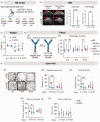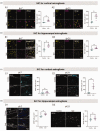Persistent neuroinflammation and behavioural deficits after single mild traumatic brain injury
- PMID: 35945692
- PMCID: PMC9670002
- DOI: 10.1177/0271678X221119288
Persistent neuroinflammation and behavioural deficits after single mild traumatic brain injury
Abstract
Despite an apparently silent imaging, some patients with mild traumatic brain injury (TBI) experience cognitive dysfunctions, which may persist chronically. Brain changes responsible for these dysfunctions are unclear and commonly overlooked. It is thus crucial to increase our understanding of the mechanisms linking the initial event to the functional deficits, and to provide objective evidence of brain tissue alterations underpinning these deficits. We first set up a murine model of closed-head controlled cortical impact, which provoked persistent cognitive and sensorimotor deficits, despite no evidence of brain contusion or bleeding on MRI, thus recapitulating features of mild TBI. Molecular MRI for P-selectin, a key adhesion molecule, detected no sign of cerebrovascular inflammation after mild TBI, as confirmed by immunostainings. By contrast, in vivo PET imaging with the TSPO ligand [18F]DPA-714 demonstrated persisting signs of neuroinflammation in the ipsilateral cortex and hippocampus after mild TBI. Interestingly, immunohistochemical analyses confirmed these spatio-temporal profiles, showing a robust parenchymal astrogliosis and microgliosis, at least up to 3 weeks post-injury in both the cortex and hippocampus. In conclusion, we show that even one single mild TBI induces long-term behavioural deficits, associated with a persistent neuro-inflammatory status that can be detected by PET imaging.
Keywords: Mild traumatic brain injury; TSPO microPET imaging; molecular MRI; neuroinflammation; persisting behavioural deficits.
Conflict of interest statement
The author(s) declared no potential conflicts of interest with respect to the research, authorship, and/or publication of this article.
Figures




Similar articles
-
Concussion, microvascular injury, and early tauopathy in young athletes after impact head injury and an impact concussion mouse model.Brain. 2018 Feb 1;141(2):422-458. doi: 10.1093/brain/awx350. Brain. 2018. PMID: 29360998 Free PMC article.
-
Tau aggregation and increased neuroinflammation in athletes after sports-related concussions and in traumatic brain injury patients - A PET/MR study.Neuroimage Clin. 2021;30:102665. doi: 10.1016/j.nicl.2021.102665. Epub 2021 Apr 7. Neuroimage Clin. 2021. PMID: 33894460 Free PMC article.
-
Interferon-β Plays a Detrimental Role in Experimental Traumatic Brain Injury by Enhancing Neuroinflammation That Drives Chronic Neurodegeneration.J Neurosci. 2020 Mar 11;40(11):2357-2370. doi: 10.1523/JNEUROSCI.2516-19.2020. Epub 2020 Feb 6. J Neurosci. 2020. PMID: 32029532 Free PMC article.
-
[Mild traumatic brain injury and postconcussive syndrome: a re-emergent questioning].Encephale. 2012 Sep;38(4):329-35. doi: 10.1016/j.encep.2011.07.003. Epub 2011 Aug 31. Encephale. 2012. PMID: 22980474 Review. French.
-
Understanding microglial responses in large animal models of traumatic brain injury: an underutilized resource for preclinical and translational research.J Neuroinflammation. 2023 Mar 9;20(1):67. doi: 10.1186/s12974-023-02730-z. J Neuroinflammation. 2023. PMID: 36894951 Free PMC article. Review.
Cited by
-
Increasing brain N-acetylneuraminic acid alleviates hydrocephalus-induced neurological deficits.CNS Neurosci Ther. 2023 Nov;29(11):3183-3198. doi: 10.1111/cns.14253. Epub 2023 May 24. CNS Neurosci Ther. 2023. PMID: 37222223 Free PMC article.
-
Context is key: glucocorticoid receptor and corticosteroid therapeutics in outcomes after traumatic brain injury.Front Cell Neurosci. 2024 Mar 11;18:1351685. doi: 10.3389/fncel.2024.1351685. eCollection 2024. Front Cell Neurosci. 2024. PMID: 38529007 Free PMC article. Review.
-
Trigeminal Sensitization in a Closed Head Model for Mild Traumatic Brain Injury.J Neurotrauma. 2024 Apr;41(7-8):985-999. doi: 10.1089/neu.2023.0328. Epub 2024 Jan 5. J Neurotrauma. 2024. PMID: 38115600 Free PMC article.
-
Cerebrospinal fluid levels of neuroinflammatory biomarkers are increased in athletes with persistent post-concussive symptoms following sports-related concussion.J Neuroinflammation. 2023 Aug 17;20(1):189. doi: 10.1186/s12974-023-02864-0. J Neuroinflammation. 2023. PMID: 37592277 Free PMC article.
-
A role for protein arginine methyltransferase 7 in repetitive and mild traumatic brain injury.Neurochem Int. 2023 Jun;166:105524. doi: 10.1016/j.neuint.2023.105524. Epub 2023 Apr 6. Neurochem Int. 2023. PMID: 37030326 Free PMC article.
References
-
- Maas AIR, Menon DK, Adelson PD, et al.. Traumatic brain injury: integrated approaches to improve prevention, clinical care, and research. Lancet Neurol 2017; 16: 987–1048. - PubMed
-
- Dewan MC, Rattani A, Gupta S, et al.. Estimating the global incidence of traumatic brain injury. J Neurosurg 2019; 130: 1080–1097. - PubMed
-
- Teasdale G, Jennett B. Assessment of coma and impaired consciousness: a practical scale. The Lancet 1974; 304: 81–84. - PubMed
Publication types
MeSH terms
Substances
LinkOut - more resources
Full Text Sources
Medical

